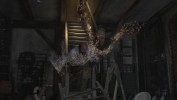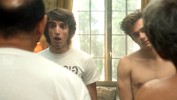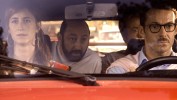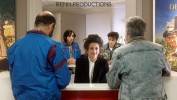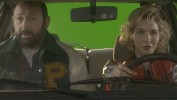Bis
DIRECTOR : Dominique Farrugia
PRODUCTION : Europacorp
VFX SUPERVISOR : Olivier Cauwet
VFX PRODUCER : Marguerite Moreau de Lizoreux

EDITOR : Charles Labriet
MUSIC : A-ha - Take On Me
NUMBER OF SHOTS : 140
Production notes
BIS
Director: Dominique Farrugia
Production: EuropaCorp – 2014
Number of VFX shots : 140
VFX Supervisor : Olivier Cauwet
VFX Procuder : Marguerite Moreau de Lizoreux
Production schedule: September 2014 to mid-december 2014

REFLECTIONS - 35 shots
In the first sequence where main characters Kad Merad and Franck Dubosc (Patrice and Eric) return to 1986, they discover their reflections in a mirror : they see themselves young as they were back then, and this is also how they see all the other characters of the movie. However, apart from their reflections, the characters still see each other as they are in the present, in 2014.
Many other sequences also play with the difference between the actors and their “young” reflections.
To create the first sequence of reflections, that are essential to the film, the performance naturally became the priority. It was important not to spend energy on technical aspects to create the reflections, but to concentrate on the acting and bond between the actors.
During the shooting, Kad Merad and Franck Dubosc were performing face to face with their “doubles” Antonin Chalon and Fabien Wolfrom. The young “doubles” were imitating Kad and Franck to give the illusion that they really were their reflections, without losing any of the energy that was put into the acting. To enhance the illusion, the decor of the room was symmetrically re-constructed, as the separation between the actors was marked by the frame of the mirror.
To make the effect more believable, BUF re-created the texture of the mirror in 3D, making it look like an old mercury mirror with visible layers, dark spots on glass, sparkles, scratches, greasy stains, as well as a slight deformation of the reflection by the imperfections of the glass, as well as a thin duplication caused by its thickness. The camera movements and lighting during the shooting was re-created in 3D along with the focus lengths simulated on the mirror so that it could be correctly integrated into the shot.
But the real challenge of this and all the other sequences including the reflection effect between Kad Merad, Franck Dubosc and their young doubles, was to correct the imperfections of acting in order to obtain a perfect synchronization between the actors and their reflections, especially the movements of their heads and hands, but also the beginnings and endings of their actions, lips, and body movements. With our optical flow tool, we re-synchronized and repositioned the parts of bodies, sometimes using more convenient elements from other takes. This post-production process enabled Dominique Farrugia to concentrate only on directing during the shooting, without worrying about visual effects.

Return to 1986 – 3 shots
When the main characters fall down the stairs in the cave of Patrice's country house, time stops and Eric and Patrice disappear within a magical particle effect, which takes them back to 1986.
In these sequences, Dominique Farrugia wished to create something memorable, a magical effect without any ambiguity, illustrating their passage to 1986 as well as back to 2014.
We decided to mark their time travel by a freeze of the action, nevertheless it doesn't affect the camera movement which continues its path. The actors were shot with two static cameras that were placed at the starting and ending positions of the virtual camera. Then the set and the actors were modeled and rendered in 3D.
The dust of the falling stairs and the luminous particles were simulated with BUF's 3D software : bstudio.
FNAC and Sushi Paradiso - 2 shots
These two sequences reveal the main characters; we discover Kad Merad's character signing his last book at FNAC store, and Franck Dubosc's character in his restaurant, Sushi Paradiso.
The effect is similar to a crash zoom with some delayed moments. The technique used is a mix between a 3D dolly and a 2D zoom. Because of the high speed of the motion, we preferred to create the movements in 3D. The set was modeled and mapped with the photographs taken from set, in order to connect different filmed places between them.

Car interiors shot in studio on green screen - 36 shots
In three different sequences, we see various characters in their cars, driving either on a highway in 2014, in 1986 Paris, or on a country road.
These sequences were shot in studio on green screen. The backgrounds were filmed in the same camera axis as the actors, matching with the focal lengths as well as the heights of the camera.
The shots of 1986 Paris were also reworked : we replaced contemporary bus stops with those from 1986 and removed all urban anachronisms. We also re-worked colors and enhanced the lighting in order to match with the choices of the cinematographer, Rémy Chevrin.
Finally, we had to remove the impression of being in a studio, by adding vibrations to cars, reflections on windshields and bodywork, and flares caused by the sun.

« Music video » 1986 - 21 shots
Eric and Patrice, returned to 1986, and are driving in a car with Patrice's parents. From the windows, they discover the setting of that period.
In this movie, music plays an important role to illustrate the year 1986. Dominique Farrugia wanted to bring us back to the eighties with a music video inspired by the visual aspect of the famous song « Take on me » by A-ha.
In order to avoid the effect of a digital filter, BUF's artists rotoscoped and drew on the archive footage provided by the production at a frame rate of 12 frames per second. This adds an authentic pencil effect and a lot of energy to the video. We also added moving rasters to avoid color swatches.

TV - 15 shots
In many sequences taking place in 1986, characters are watching television, and we can see TV shows and commercials illustrating that period. BUF integrated various footage from TV's of that time : commercials, eight o'clock news, football match etc.

Nightclub “La Main Jaune” - 1 shot
In one shot, we see Eric and Caroline at “La Main Jaune”, a famous nightclub in 1986. The wall of the nightclub is covered with square mirrors, which reflects multiple images of young Eric and Caroline.
To create the effect of this nightclub scene, we shot the action in two passes. The first pass is a dolly-in, shot on green screen with Franck Dubosc et Eden Ducourant playing the scene. The second pass imitates the same camera movement, with Fabian and Eden acting in front of a smooth mirror in order to capture their reflections. BUF's work consisted in re-compositing these two passes and re-creating a 3D wall composed of numerous square mirrors.
Ending and closing credits - 2 shots
In the last shot of the movie, Eric and Patrice are finally back in 2014, relieved, they promise not to drink so much anymore. They are heading towards the house and then disappear again. The camera then moves up the house, following the luminous particles up into the sky, and we see the first title cards of the credits appear on it.
In this last camera movement, BUF created the roof of the house, extension of the tree on foreground and the star field, as well as the luminous particles raising up to the sky and forming the first title cards.
Clean-up, restore & various effects - 25 shots
Various sequences, interior and exterior settings.
In these various sequences appearing in the movie, our work consisted in cleaning up the shots filmed in 2014 but supposed to be taking place in 1986, as they contained a lot of anachronisms.
This clean-up and restore work especially affected road signs, tags, digicodes and, lane markings. We also removed contemporary cars running on streets and replaced them by CG cars, as well as erased or disguised reflections and shadows of Franck Dubosc and Kad Merad which had been filmed by accident. This helps the audience to not doubt at any moment that our characters were appearing young in their reflections and shadows, witnessing their travel in the past.






